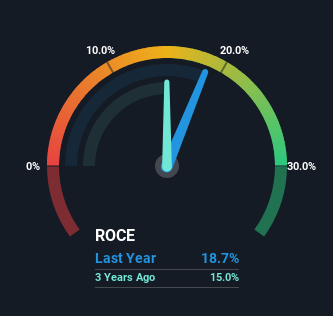- United States
- /
- Specialty Stores
- /
- NYSE:SAH
The Return Trends At Sonic Automotive (NYSE:SAH) Look Promising

What are the early trends we should look for to identify a stock that could multiply in value over the long term? One common approach is to try and find a company with returns on capital employed (ROCE) that are increasing, in conjunction with a growing amount of capital employed. Basically this means that a company has profitable initiatives that it can continue to reinvest in, which is a trait of a compounding machine. So when we looked at Sonic Automotive (NYSE:SAH) and its trend of ROCE, we really liked what we saw.
Return On Capital Employed (ROCE): What Is It?
For those that aren't sure what ROCE is, it measures the amount of pre-tax profits a company can generate from the capital employed in its business. To calculate this metric for Sonic Automotive, this is the formula:
Return on Capital Employed = Earnings Before Interest and Tax (EBIT) ÷ (Total Assets - Current Liabilities)
0.19 = US$575m ÷ (US$5.1b - US$2.0b) (Based on the trailing twelve months to June 2023).
Therefore, Sonic Automotive has an ROCE of 19%. In absolute terms, that's a satisfactory return, but compared to the Specialty Retail industry average of 13% it's much better.
View our latest analysis for Sonic Automotive

In the above chart we have measured Sonic Automotive's prior ROCE against its prior performance, but the future is arguably more important. If you're interested, you can view the analysts predictions in our free report on analyst forecasts for the company.
So How Is Sonic Automotive's ROCE Trending?
We like the trends that we're seeing from Sonic Automotive. The numbers show that in the last five years, the returns generated on capital employed have grown considerably to 19%. The amount of capital employed has increased too, by 66%. The increasing returns on a growing amount of capital is common amongst multi-baggers and that's why we're impressed.
In another part of our analysis, we noticed that the company's ratio of current liabilities to total assets decreased to 39%, which broadly means the business is relying less on its suppliers or short-term creditors to fund its operations. This tells us that Sonic Automotive has grown its returns without a reliance on increasing their current liabilities, which we're very happy with.
The Key Takeaway
All in all, it's terrific to see that Sonic Automotive is reaping the rewards from prior investments and is growing its capital base. And a remarkable 181% total return over the last five years tells us that investors are expecting more good things to come in the future. With that being said, we still think the promising fundamentals mean the company deserves some further due diligence.
If you want to know some of the risks facing Sonic Automotive we've found 2 warning signs (1 is a bit concerning!) that you should be aware of before investing here.
While Sonic Automotive isn't earning the highest return, check out this free list of companies that are earning high returns on equity with solid balance sheets.
New: Manage All Your Stock Portfolios in One Place
We've created the ultimate portfolio companion for stock investors, and it's free.
• Connect an unlimited number of Portfolios and see your total in one currency
• Be alerted to new Warning Signs or Risks via email or mobile
• Track the Fair Value of your stocks
Have feedback on this article? Concerned about the content? Get in touch with us directly. Alternatively, email editorial-team (at) simplywallst.com.
This article by Simply Wall St is general in nature. We provide commentary based on historical data and analyst forecasts only using an unbiased methodology and our articles are not intended to be financial advice. It does not constitute a recommendation to buy or sell any stock, and does not take account of your objectives, or your financial situation. We aim to bring you long-term focused analysis driven by fundamental data. Note that our analysis may not factor in the latest price-sensitive company announcements or qualitative material. Simply Wall St has no position in any stocks mentioned.
About NYSE:SAH
Sonic Automotive
Operates as an automotive retailer in the United States.
Solid track record established dividend payer.
Similar Companies
Market Insights
Community Narratives



